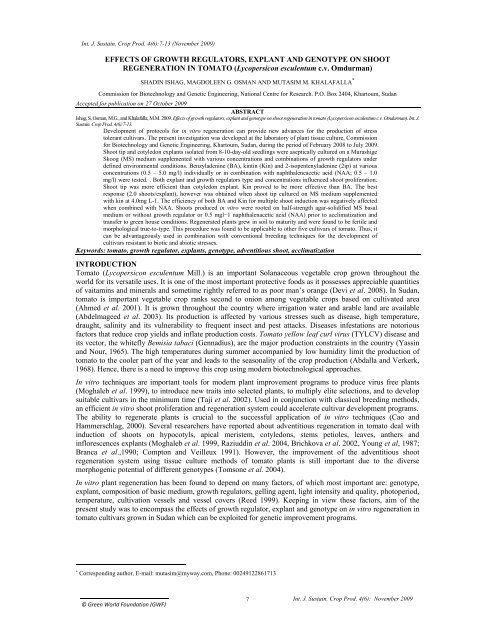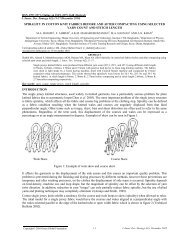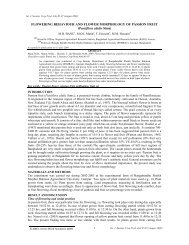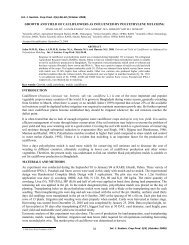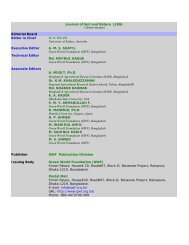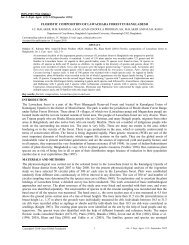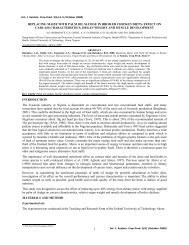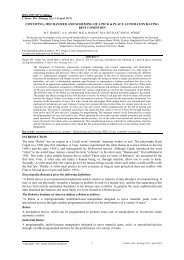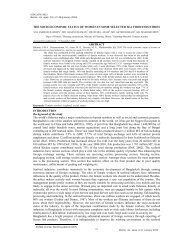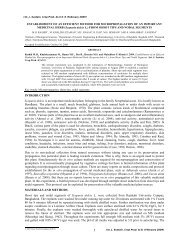EFFECTS OF GROWTH REGULATORS, EXPLANT AND ...
EFFECTS OF GROWTH REGULATORS, EXPLANT AND ...
EFFECTS OF GROWTH REGULATORS, EXPLANT AND ...
Create successful ePaper yourself
Turn your PDF publications into a flip-book with our unique Google optimized e-Paper software.
Int. J. Sustain. Crop Prod. 4(6):7-13 (November 2009)<br />
<strong>EFFECTS</strong> <strong>OF</strong> <strong>GROWTH</strong> <strong>REGULATORS</strong>, <strong>EXPLANT</strong> <strong>AND</strong> GENOTYPE ON SHOOT<br />
REGENERATION IN TOMATO (Lycopersicon esculentum c.v. Omdurman)<br />
SHADIN ISHAG, MAGDOLEEN G. OSMAN <strong>AND</strong> MUTASIM M. KHALAFALLA ∗<br />
Commission for Biotechnology and Genetic Engineering, National Centre for Research. P.O. Box 2404, Khartoum, Sudan<br />
Accepted for publication on 27 October 2009<br />
ABSTRACT<br />
Ishag, S, Osman, M.G., and Khalafalla, M.M. 2009. Effects of growth regulators, explant and genotype on shoot regeneration in tomato (Lycopersicon esculentum c.v. Omdurman). Int. J.<br />
Sustain. Crop Prod. 4(6):7-13.<br />
Development of protocols for in vitro regeneration can provide new advances for the production of stress<br />
tolerant cultivars. The present investigation was developed at the laboratory of plant tissue culture, Commission<br />
for Biotechnology and Genetic Engineering, Khartoum, Sudan, during the period of February 2008 to July 2009.<br />
Shoot tip and cotyledon explants isolated from 8-10-day-old seedlings were aseptically cultured on a Murashige<br />
Skoog (MS) medium supplemented with various concentrations and combinations of growth regulators under<br />
defined environmental conditions. Benzyladenine (BA), kintin (Kin) and 2-isopentenyladenine (2ip) at various<br />
concentrations (0.5 – 5.0 mg/l) individually or in combination with naphthaleneacetic acid (NAA; 0.5 – 1.0<br />
mg/l) were tested. . Both explant and growth regulators type and concentrations influenced shoot proliferation.<br />
Shoot tip was more efficient than cotyledon explant. Kin proved to be more effective than BA. The best<br />
response (2.0 shoots/explant), however was obtained when shoot tip cultured on MS medium supplemented<br />
with kin at 4.0mg L-1. The efficiency of both BA and Kin for multiple shoot induction was negatively affected<br />
when combined with NAA. Shoots produced in vitro were rooted on half-strength agar-solidified MS basal<br />
medium or without growth regulator or 0.5 mgl−1 naphthalenacetic acid (NAA) prior to acclimatization and<br />
transfer to green house conditions. Regenerated plants grew in soil to maturity and were found to be fertile and<br />
morphological true-to-type. This procedure was found to be applicable to other five cultivars of tomato. Thus, it<br />
can be advantageously used in combination with conventional breeding techniques for the development of<br />
cultivars resistant to biotic and abiotic stresses.<br />
Keywords: tomato, growth regulator, explants, genotype, adventitious shoot, acclimatization<br />
INTRODUCTION<br />
Tomato (Lycopersicon esculentum Mill.) is an important Solanaceous vegetable crop grown throughout the<br />
world for its versatile uses. It is one of the most important protective foods as it possesses appreciable quantities<br />
of vaitamins and minerals and sometime rightly referred to as poor man’s orange (Devi et al. 2008). In Sudan,<br />
tomato is important vegetable crop ranks second to onion among vegetable crops based on cultivated area<br />
(Ahmed et al. 2001). It is grown throughout the country where irrigation water and arable land are available<br />
(Abdelmageed et al. 2003). Its production is affected by various stresses such as disease, high temperature,<br />
draught, salinity and its vulnerability to frequent insect and pest attacks. Diseases infestations are notorious<br />
factors that reduce crop yields and inflate production costs. Tomato yellow leaf curl virus (TYLCV) disease and<br />
its vector, the whitefly Bemisia tabaci (Gennadius), are the major production constraints in the country (Yassin<br />
and Nour, 1965). The high temperatures during summer accompanied by low humidity limit the production of<br />
tomato to the cooler part of the year and leads to the seasonality of the crop production (Abdalla and Verkerk,<br />
1968). Hence, there is a need to improve this crop using modern biotechnological approaches.<br />
In vitro techniques are important tools for modern plant improvement programs to produce virus free plants<br />
(Moghaleb et al. 1999), to introduce new traits into selected plants, to multiply elite selections, and to develop<br />
suitable cultivars in the minimum time (Taji et al. 2002). Used in conjunction with classical breeding methods,<br />
an efficient in vitro shoot proliferation and regeneration system could accelerate cultivar development programs.<br />
The ability to regenerate plants is crucial to the successful application of in vitro techniques (Cao and<br />
Hammerschlag, 2000). Several researchers have reported about adventitious regeneration in tomato deal with<br />
induction of shoots on hypocotyls, apical meristem, cotyledons, stems petioles, leaves, anthers and<br />
inflorescences explants (Moghaleb et al. 1999, Raziuddin et al. 2004, Brichkova et al. 2002, Young et al, 1987;<br />
Branca et al.,1990; Compton and Veilleux 1991). However, the improvement of the adventitious shoot<br />
regeneration system using tissue culture methods of tomato plants is still important due to the diverse<br />
morphogenic potential of different genotypes (Tomsone et al. 2004).<br />
In vitro plant regeneration has been found to depend on many factors, of which most important are: genotype,<br />
explant, composition of basic medium, growth regulators, gelling agent, light intensity and quality, photoperiod,<br />
temperature, cultivation vessels and vessel covers (Reed 1999). Keeping in view these factors, aim of the<br />
present study was to encompass the effects of growth regulator, explant and genotype on in vitro regeneration in<br />
tomato cultivars grown in Sudan which can be exploited for genetic improvement programs.<br />
∗ Corresponding author, E-mail: mutasim@myway.com, Phone: 00249122861713<br />
© Green World Foundation (GWF)<br />
7<br />
Int. J. Sustain. Crop Prod. 4(6): November 2009
Ishag et al.<br />
MATERIAL <strong>AND</strong> METHOD<br />
Plant material<br />
Seeds of tomato cultivars used in this study were obtained from the Agricultural Research Corporation, Shambat,<br />
Sudan.<br />
Surface sterilization and seed germination<br />
Seeds were washed under continuously running tap water for 15 minutes then washed by sterile distilled water.<br />
Under laminar flow cabinet seeds were disinfected with Clorox (0.5 % free chlorine) at concentration of 15%<br />
v/v for 15 mints then rinsed three times with sterile distilled water.<br />
After surface sterilization, ten seeds were directly transferred to culture bottle and incubated for 10 days at<br />
25°C±2 with a 16 h photoperiod. Data on seed germination were recorded after 10 days of inoculation.<br />
Four different basal media namely, full–salt strength MS (Murshige and skoog, 1962) medium, half –salt<br />
strength MS medium, Full –salt strength B5 (Gamborg et al. 1968) medium and half –salt strength B5 medium,<br />
were evaluated for their effects on in vitro germination of tomato seed. In vitro raised explants (Shoot tip of<br />
1-1.5 cm length and cotyledon of 0.5-1cm length from 10-15 days – old seedling ) .<br />
Effects of plant growth regulators and genotypes on multiple shoots Induction<br />
Cytokinine (2ip, BA and KN) with different concentrations (0.1, 0.5, 1.0, 2.0, 3.0, 4.0 and 5.0 mg/l) were used<br />
singly or in combination with and auxin (NAA) to assess the morphogenetic response of the explants. Cultures<br />
were incubated for six weeks at 25°C±2 under cool white fluorescent light and 16 photoperiod.<br />
Rooting of in vitro regenerated shoots and plantlet acclimatization<br />
Shoots were excised and cultured on full and half-strength of MS media supplemented with different<br />
concentrations (0.0, 0.1, 0.5 and 1.0 mg/L) of IAA, NAA and IBA for root induction. For acclimatization in<br />
vitro rooted shoots were removed from rooting medium and washed to remove adhering gel and transplanted to<br />
plastic pots containing autoclaved garden soil and sand at 1:1 ratio. Plants were kept under culture room<br />
conditions for 7 days then transferred to green house and placed under shade until growth was observed.<br />
Culture condition and data analysis<br />
Results were observed at regular intervals and data were collected from three independent experiments and<br />
analyzed by using analysis of variance procedure (ANOVA) on excel computer program. Means were separated<br />
by Duncan’s multiple range test (DMRT) (Duncan, 1955) and presented as average ± standard error (SE).<br />
RESULT <strong>AND</strong> DISCUSSION<br />
In order to establish an efficient in vitro regeneration protocol for tomato Omdurman cultivar, mature seeds<br />
were surface sterilized by Clorox (Sodium hypochlorite 0.5 % free chlorine) at concentration of 15% v/v for 15<br />
mints before in vitro ge<br />
rmination. Disinfection of seeds by using Clorox has already been proved to be essential in tomato tissue culture<br />
and in vitro seed germination (Chaudhry et al.2007). Higher germination rate is an important factor for<br />
establishing plant tissue culture and be particularly useful when there is a need to submit a uniform set of<br />
seedlings to a treatment (Sakhanokho et al. 2001). Tomato in vitro seed germination was observed after 8-<br />
10days in five different basal media evaluated for their effects on seed germination. The highest rate of<br />
germination (100%) was obtained by using half-strength MS basal media (Table1). This result is in line with<br />
Gubis et al. (2003) and Raj et al. (2005) who used half strength MS medium for in vitro germination of tomato<br />
seed.<br />
Table 1. The effects of different basal media on in vitro germination of tomato seed<br />
Basal media Germination (%)<br />
MS 96<br />
1/2 MS 100<br />
B5 75<br />
1/2 B5 65<br />
MB 58<br />
Determination of the most optimal types and concentrations of plant growth regulators as medium constituents<br />
is one of the most important aspects of successful micropropagation, among other in vitro factors (Ružić and<br />
Vujović, 2008). Here in this investigation, the shoot regeneration of tomato cultivar Omdurman has been<br />
stimulated in vitro from two different types of explants by using various growth regulator used singly or in<br />
combinations (Table 2).<br />
8<br />
Int. J. Sustain. Crop Prod. 4(6): November 2009
Table 2. Effect of cytokinins on shoot induction from shoot tip explant and cotylednary of tomato cultivar Omdurman after 6<br />
weeks of culture<br />
PG R Con.<br />
Reg.<br />
response (%)<br />
Effects of growth regulators, explant and genotype on shoot regeneration in tomato (Lycopersicon esculentum c.v. Omdurman)<br />
Shoot tip Cotyledonary node<br />
Number of<br />
shoots/ explant<br />
(mean ± SE )<br />
Shoot length /<br />
explant<br />
( mean ± SE )<br />
9<br />
Reg.<br />
response (%)<br />
Number of shoots/<br />
explant<br />
(mean ± SE)<br />
Shoot length /explant<br />
( mean ± SE )<br />
0.0 75 1.0± 0.0 e 4.4±0.5 cdef 77 1.0±0.0 e 1.9±0.3 ijkl<br />
0.1 85 1.2± 0.1 cde 4.5±1. cd 85 1.0±0.0 e 1.0± 0 l<br />
0.5 85 1.1± 0.09 cde 3.2±0.4 fghi 85 1.0±0 .0 e 1.2±0.1 kl<br />
BA<br />
1.0<br />
2.0<br />
80 (callus)<br />
80 (callus)<br />
1.0± 0.0 e<br />
1.0±0.0 e<br />
1.4±0.15 jkl<br />
1.2±0.09 kl<br />
80 (callus)<br />
85 (callus)<br />
1.06±0.06 de<br />
1.0±0.0 e<br />
1.1± 0 kl<br />
1.1± 0 kl<br />
3.0 80 (callus) 1.0±0.0 e 1.1±0.06 kl 80 (callus) 1.0±0 .0 e 1.1± 0.1 kl<br />
4.0 75 (callus) 1.0±0.0 e 1.4±0.10 jkl 80 (callus) 1.2±0.1 cde 1.6±0.2 jkl<br />
5.0 70 (callus) 1.0±0.0 e 1.2±0.08 kl 80 (callus) 1.0±0.0 e 1.2± 0.1 kl<br />
0.1 100 1.3±0.1 bcd 4.7±0.4 cd 100 1.0±0.0 e 1.6± 0.1 jkl<br />
0.5 100 1.2±0.1 cde 4.5±0.4 cde 100 1.0±0.0 e 2.6±0.1 hij<br />
1.0 100 1.3±0.1 bcd 5.4±0.4 bc 100 1.1±0.09 cde 2.7± 0.2 hi<br />
Kin 2.0 100 1.2±0.1 cde 5.6±0.3 abc 100 1.2±0.1 cde 3.5± 0.2 defgh<br />
3.0 100 1.5±0.1 b 5.5±0.3 abc 100 1.3±0.1 bcd 4.6± 0.3 cd<br />
4.0 100 2±0.0 a 4.6±0.3 cd 100 1.4±0.13 bc 6.6± 0.3 a<br />
5.0 100 1.3±0.1 bcd 3.0±0.09 hi 100 1.3±0.1 bcd 4.7± 0.5 cd<br />
0.1 100 1.2±0.1 cde 3.0±0.3 hi 100 1.2±0.1 cde 5.0± 0.7 bc<br />
0.5 100 1.2±0.1 cde 5.1±0.3 bc 100 1.0±0.0 e 6.2± 0.6 ab<br />
1.0 100 1.2±0.1 cde 3.7±0.3defgh 100 1.2±0.1 cde 4.4± 0.3 cdefg<br />
2ip 2.0 100 1.3±0.1 bcd 4.5±0.2 cde 100 1.1±0.09 cde 3.2± 0.2 efgh<br />
3.0 100 1.2±0.1 cde 3.1±0.3 ghi 100 1.06±0.06 de 2.1±0 ijkl<br />
4.0 90 (callus) 1.0±0.0 e 2.6±0.2 hij 90 (callus) 1.06±0.06 de 2.4± 0.1 hijk<br />
5.0 90 (callus) 1.0±0.0 e 2.1±0.2 ijkl 90 (callus) 1.0±0.0 e 1.8± 0.1 ijkl<br />
*Means followed by the same letter within columns are not significantly different at the 5% level of significance using Duncan’s multiple range test<br />
Multiple shoots regeneration of tomato cultivar Omdurman was initiated from the cotyledon and shoot tip<br />
explants after 3weeks of culture (Figure 1a). The frequency of shoot formation was influenced by both the type<br />
and concentration of phytohormones used.<br />
The dose of cytokinin is known to be critical in multiple shoots induction (Abdellatef and Khalafalla, 2007).<br />
Therefore, in this study we compared the response of both explants to various concentrations of BA, kin and 2ip.<br />
Kin at different concentrations induced more shoots per explant compared to BA and 2ip at the same<br />
concentrations (Table 2). Indicating that, kin was more effective than BA and 2ip for multiple shoot production<br />
from tomato cotyledon and shoot tip explants. Also our result showed that the shoot tip was more efficient for<br />
multiple shoot induction in tomato than cotyledon explant (Table 2). Gubis et al. 2004 reported that the<br />
frequency of adventitious shoot regeneration differed depending on the type of explants and both the type and<br />
concentration of growth regulators added to the regeneration medium. Moreover, Plana et al. 2005 reported that,<br />
tomato adventitious shoot capacity depend on explant source.<br />
The results showed that at higher concentration of the cytokinin the regeneration percentage and shoot<br />
regeneration frequencies were decreased (Table 2). This is mainly, because at higher cytokinin level explants<br />
produced excessive callus and failed to improve the efficiency of shoot multiplication. Thiem (2003) reported<br />
that callus growth on explant usually interfere with the propagation process.<br />
In order to evaluate the synergistic effect of BA and Kin with NAA for direct shoot regeneration, it was found<br />
that, the combination of NAA with BA or Kin negatively affected the multiplication rate of the tomato<br />
compared with cytokinine used singly (Table 3).The inhibitory effect of auxin on multiple shoot induction has<br />
been demonstrated in numbers of plants. In cotton (Abdellatef and Khalafalla, 2007), faba bean (Khalafalla and<br />
Hattori, 2000) and mung bean (Gulati and Jaiwal, 1992) it was reported that the addition of NAA to medium<br />
containing cytokinin did not improve shoot multiplication rate.<br />
Int. J. Sustain. Crop Prod. 4(6): November 2009
Ishag et al.<br />
Table 3. Effect of cytokinins and auxin combinations on shoot induction from shoot tip explant of tomato cultivar<br />
Omdurman after 6 weeks of culture<br />
BA Kin NAA Regeneration response %<br />
Number of shoots / explant<br />
( mean ± SE )<br />
Shoot length / explant<br />
( mean ± SE )<br />
0.5 0.0 0.1 60 1± 0 c 1.6± 0.1 j<br />
1.0 0.0 77 1.06±0.06 bc 4.8± 0.2 def<br />
2.0 0.0 66 1± 0 c 3.6± 0.2 fgh<br />
3.0 0.0 74 1.06±0.06 bc 2.7± 0.3 hi<br />
4.0 0.0 65 1± 0 c 4.2± 0.4 efg<br />
0.5 0.0 0.5 65 (callus) 1± 0 c 5.3± 0.5 cde<br />
1.0 0.0 65 (callus) 1± 0 c 3.1± 0.3 ghi<br />
2.0 0.0 65 (callus) 1± 0 c 2.3± 0.1 hi<br />
3.0 0.0 60 (callus) 1± 0 c 2.4± 0.1 hi<br />
4.0 0.0 60 (callus) 1± 0 c 2.3± 0.1 hi<br />
0.0 0.5 0.1 64 1± 0 c 6.5± 0.47 abc<br />
0.0 1.0 86 1.2±0.1 b 7.2± 0.47 ab<br />
0.0 2.0 60 1± 0 c 5.8± 0.57 bcd<br />
0.0 3.0 95 1.4±0.13 a 7.7± 0.3 a<br />
0.0 4.0 84 1.2± 0.1 b 6.1± 0.7 bcd<br />
0.0 0.5 0.5 77 1.06± 0.06 bc 6.5± 0.5 abc<br />
0.0 1.0 74 1.06± 0.06 bc 5.2± 0.6 cde<br />
0.0 2.0 71 1.06± 0.06 bc 5.4± 0.5 cde<br />
0.0 3.0 63 1± 0 c 5.3± 0.5 cde<br />
0.0 4.0 75 1.06±0.06 bc 5.2± 0.5 cde<br />
*Means followed by the same letter within columns are not significantly different at the 5% level of significance using Duncan’s multiple<br />
range test<br />
The plant regeneration capacity of this procedure was found to be applicable to five other tomato genotypes<br />
(Table 4). The best result (2shoots/explant) for number of multiple shoots per explant was obtained by the<br />
cultivar Omdurman. Earlier it was reported that the regeneration response of tomato to plant growth regulators<br />
(PGRs) has been to be highly genotype-specific, and as such, the type and concentration suitable for one<br />
genotype may not be optimal for others (Frankenberger et al. 1981; Kurtz and Lineberger, 1983; Plastira and<br />
Perdikaris, 1997; Bhatia et al. 2004).<br />
Table 4: Effect of auxins on rooting of in vitro derived shoots of tomato, cv Umdorman after six weeks of culture<br />
Auxin Conc. Full MS 1/2 MS<br />
Rooting Number of roots Root Length Rooting Number of Root length<br />
response (%) / explant ( mean ± SE ) (mean ± SE) response (%) roots / explant<br />
( mean ± SE )<br />
(mean ± SE)<br />
IBA 0.0 100 9.3±0.8 def 4.15±0.2 hij 100 12± 0.8 cdef 5.4±0.3 cdef<br />
0.1 100 7.7±1.2 ef 5.65±0.3bcde 100 6± 0.7 f 7.40±0.2 a<br />
0.5 100 8.4±1.3 ef 5.9±0.2 bcd 80 7± 0.6 ef 7.35±0.1 a<br />
1.0 80 (callus) 15±1.5 abcde 5.1±0.2 defg 85 (callus) 7± 0.5 ef 7.15±0.2 a<br />
IAA 0.1 100 10±1.2 def 4.75±0.2 fghi 89 13± 1.6 bcdef 5.5±0.2 cdef<br />
0.5 100 11±1.8 cdef 5.15±0.2 def 100 21±1.7 ab 6.1±0.2 bc<br />
1.0 70 16±1.5 abcde 4.7±0.2 fghi 100 21± 0.7 a 6.3±0.2 b<br />
NAA 0.1 80 19±1.6 abc 3.95±0.2 ij 100 20± 1.5 ab 4.95±0.2 efgh<br />
0.5 78 17±1.7 abcd 3.35±0.1 jk 100 22± 0.9 a 4.3±0.2 ghi<br />
1.0 70 (callus) 9.6±1 def 2.3±0.1 l 70 (callus) 11± 1.1 cdef 2.85±0.1 kl<br />
*Means followed by the same letter within columns are not significantly different at the 5% level of significance using Duncan’s multiple<br />
range test<br />
Regenerated shoots were excised and rooted on full and half-strength MS medium without or with different<br />
levels of NAA, IAA, or IBA. Our result showed that 100% rooting was obtained in both full and half-strength<br />
MS medium without growth regulators (Table 5).<br />
Table 5. Mean number of shoots (±standard error) formed on shoot tip explants of six genotypes of tomato after six weeks of<br />
culture on MS medium supplemented with kin at 4.0 mg/l.<br />
Genotype Regenerating culture %<br />
Number of shoots /explants<br />
( mean ± SE )<br />
Shoot length / explants<br />
( mean ± SE )<br />
Omdurman 100 2.0 ± 0.1 a 7.9±0.3 a<br />
Jazeira 100 1.1 ± 0.09 c 8.0 ±0.2 a<br />
Baledi 100 1 .0 ± 0.0 c 4.6±0.4 b<br />
Peto 86 100 1.8 ± 0.09 a 8.0±0.3 a<br />
Castle Rock 100 1.5 ± 0.1 b 8.3±0.5 a<br />
Strain -B 100 1.2 ± 0.1 bc 7.5±0.3 a<br />
*Means followed by the same letter within columns are not significantly different at the 5% level of significance using Duncan’s multiple<br />
range test.<br />
10<br />
Int. J. Sustain. Crop Prod. 4(6): November 2009
c<br />
a<br />
Effects of growth regulators, explant and genotype on shoot regeneration in tomato (Lycopersicon esculentum c.v. Omdurman)<br />
Similarly, Mensuali-Sodi et al. 1995 reported that tomato in vitro rooting does not require any exogenous plant<br />
growth regulators. However, during our study, cultivation on auxin-containing half-strength MS medium<br />
resulted in a large number of rooted microshoots (22± 0.9) and longer root (7.4 ± 0.9 cm) than cultivation on an<br />
auxin-free medium. These results can be explained by the promotive effect of auxins on root initials, as<br />
observed by De Klerk et al. (1999). The beneficial effect of using half-strength MS medium for rooting of in<br />
vitro induced shoots has already been reported for tomato. Devi et al. 2008 reported that the best rooting was<br />
found to be in half-strength medium supplemented with 0.2mg/l IBA. After well established root (Figure b)<br />
plantlets were subjected to acclimatization. Plantlets were removed from rooting medium after four weeks of<br />
incubation and transferred to plastic pots containing autoclaved soil and sand at the rate 1:1 covered with glass<br />
bottle to maintain humidity and were kept under culture room conditions for three weeks (Figure 1c). After three<br />
weeks, glass bottles were removed and transferred to green house and placed under shade until growth was<br />
observed. 95% of plants survived and all were morphologically normal (Figure 1d)<br />
d<br />
b<br />
Figure 1. In vitro induction of multiple shoots and plant regeneration of tomato cultivar of Omdurman (a) Multiple shoots<br />
induced from cotyledonary explants, (b) In vitro rooted shoot on half – strength MS basal medium supplemented with IBA<br />
(0.1 mg/L), (c) Potting up and hardening of the plantlets, (d) Tomato plant established in soil.<br />
In conclusion development of an efficient tissue culture and plant regeneration protocol for tomato genotypes<br />
grown in Sudan is the first step towards the application of modern technology in improving tomato breeding<br />
such as using plant tissue culture technology in the area of selection resistance and production of artificial seeds.<br />
ACKNOWLEDGMENT<br />
The first author thanks Sudan Academy of Sciences, Ministry of Science and Technology for the scholarship.<br />
We thanks Agricultural Research and Technology Corporation, Shambat station, for providing seed material and<br />
Commission for Biotechnology and Genetic Engineering for providing laboratory facilities<br />
REFERENCES<br />
Abdalla, A. A., and Verkerk, K. 1968. Growth, flowering and fruit set of the tomato at high temperature. Neth. J.<br />
Agr. Sci, 16: 71-76.<br />
Abdellatef, E., and Khalafallah, M.M. 2007. Adventitious shoot formation and plant regeneration in medium<br />
staple cotton (Gossypium hirsitum L.) cultivar (Barac B-67). Int. J. Agri. Biol, 9(6): 913- 916.<br />
Abdelmageed, A.H, Gruda, N., and Geyer, B. 2003. Effect of high temperature and heat shock on tomato<br />
(Lycopersicon esculentum Mill) genotypes under controlled conditions. Deutscher Tropentag 2003, Göttingen,<br />
8-10 October 2003. www.tropentag.de/2003/abstract/full/50.pdf<br />
11<br />
Int. J. Sustain. Crop Prod. 4(6): November 2009
Ishag et al.<br />
Ahmed, N.E., Kanan, H.O., Sugimoto, Y. Ma, Y. Q., and Inanaga, S. 2001. Effect of imidacloprid on incidence<br />
of Tomato yellow leaf curl virus. Plant Dis, 85:84-87.<br />
Bhatia, P, Ashwath, N., Senaratna, T, and Midmore, D. 2004.Tissue culture studies of tomato (Lycopersicon<br />
esculentum). Plant Cell Tiss. Organ Cult, 78:1–21.<br />
Branca, C., Bucci, G., Domiano, P., Ricci, A., and Bassi, M. 1990. Auxin: structure and activity on tomato<br />
morphogenesis invitro and pea stem elongation. Plant Cell Tiss. Org. Cult, 24: 105-114.<br />
Brichkova, G.G., Maneshina T.V., and Kartel, N.A. 2002. Optimization of the nutrient medium for effective<br />
regeneration of tomatoes (Lycopersicon esculentum Mill.) in vitro.Vestsi-Natsyyanal'nai-Akademii-Navuk-<br />
Belarusi.-Seryya-Biyalagichnykh- Navuk. 2: 47-52 [CAB Abst. 2002/08-2003/10].<br />
Cao, X., and Hammerschlag, F.A. 2000. Improved shoot organogenesis from leaf explants of high bush<br />
blueberry. Hortscience, 35: 945-947<br />
Chaudhary, Z., Afroz A., and Rashid. H. 2007. Effect of variety and plant growth regulators on callus<br />
proliferation and regeneration response of three tomato cultivars (Lycopersicon esculentum). Pak. J. Bot., 39(3):<br />
857-869.<br />
Compton, M.E., and Veillux. R.E. 1991. Shoot root and flower morphogenesis on tomato inflorescence explants.<br />
Plant Cell Tiss. Org. Cult, 24: 223-231.<br />
De Klerk G.J., van der Krieken, W.M., and De Jong, J.C. 1999. The formation of adventitious roots: new<br />
concepts, new possibilities. In vitro Cell Dev Biol;35:189–99.<br />
Devi, M., Dhaliwal, M.S., Kaur, A., and Gosal, S.S. 2008. Effect of growth regulators on in vitro morphogenetic<br />
response of tomato. Indian Journal of Biotechnology, 7:526- 530.<br />
Duncan, D. B. 1955. Multiple range and multiple F test. Biometrics, 11: 1- 42.<br />
Frankenberger, E. A., Hasegawa, P. M., and Tigchelaar, E. C. 1981. Influence of environment and<br />
developmental state on the shoot-forming capacity of tomato genotypes. Z. Pflanzenphysiol, 102:221–232.<br />
Gamborg, O. L., Miller, R. A., and Ojima, K. 1968. Nutrient requirements of suspension cultures of soybean<br />
root cells. Exp. Cell Res, 50:151–168.<br />
Gubis, J., Lajchová, Z., Faragó, J., and Jureková, Z. 2004. Effect of growth regulators on shoot induction<br />
and plant regeneration in tomato (Lycopersicon esculentum Mill.) Biologia, Bratislava, 59 (3): 405-408.<br />
Gubiš, J., Lajchová, Z., Faragó, J., and Jureková, Z. 2003.Effect of genotype and explant type on shoot<br />
regeneration in tomato (Lycopersicon esculentum Mill.) in vitro. Czech Journal of Genetics and Plant<br />
Breeding, 39: 9–14.<br />
Gulati, A., and Jaiwal, P.K. 1992. In vitro induction of multiple shoots and plant regeneration from shoots tip of<br />
mung bean (Vigna radiate (L.) Wilczek). Plant cell tiss. Org. Cult, 29: 199-205.<br />
Khalaflla, M.M., and Hattori, K. 2000. Differential in vitro direct shoot regeneration responses in embryo<br />
axis and shoot tip explant of faba bean. Breed. Sci., 50: 117-22.<br />
Kurtz, S. M., and Lineberger, R. D. 1983.Genotypic differences in morphogenic capacity of cultured leaf<br />
explants of tomato. J. Am. Soc. Hort. Sci, 108:710–714.<br />
Mensuali-Sodi, A., Panizza, M., and Tognoni F. 1995. Endogenous ethylene requirement for adventitious root<br />
induction and growth in tomato cotyledons and lavandin microcutting in vitro. Plant Growth Regul,17:205–212.<br />
Moghaleb, R.E.A., Saneoka, H., and Fujita, K. 1999. Plant regeneration from hypocotyls and cotyledon<br />
explants of tomato (Lycopersicon esculentum). Soil Sci. Plant Nutr, 45: 639-646.<br />
12<br />
Int. J. Sustain. Crop Prod. 4(6): November 2009
Effects of growth regulators, explant and genotype on shoot regeneration in tomato (Lycopersicon esculentum c.v. Omdurman)<br />
Murashige, T., and Skoog, F. 1962. A revised medium for rapid growth and bioassays with tobacco tissue<br />
cultures. Physiol. Plant, 15:473-497.<br />
Palana, D., Marta, A., Regla, M.L., Marilyn, F., Alvarez, F., and Moya, C. 2005. A new in vitro regeneration<br />
protocol in tomato (Lycopersicon esculentum). Cultivos Tropicales, 26 :(2) 17-20.<br />
Plastira, V. A., and Perdikaris, A. K. 1997. Effect of genotype and explant type on regeneration frequency of<br />
tomato in vitro. Acta Hort, 447:231–234.<br />
Raj, S.K., Singh, R.,. Pandey, S.K., and Singh, B.P. 2005. Agrobacterium mediated tomato transformation<br />
and regeneration of transgenic lines expressing tomato leaf curl virus coat protein gene for resistance against<br />
TLCV infection. Research communications. Current Sci, 88: (10)1674-1679.<br />
Raziuddin, S., and Salim, H.J. Chaudhary, T. Mohammad, A., and Ali. S. 2004. Hormonal effect on callus<br />
induction in Tomato. Sarhad J. Agric, 20(2): 223-225.<br />
Reed, B.M. 1999. Design a micropropagation system: Workshop presentation from the 1998 SIVB Congr. On in<br />
vitro Biology. In Vitro Cell Dev. Biol. Plant., 35: 275-284.<br />
Ružić DJ. V., and Vujović, T. I. 2008. The effects of cytokinin types and their concentration on in vitro<br />
multiplication of sweet cherry cv. Lapins (Prunus avium L.) Hort. Sci. (Prague), 35, (1): 12–21.<br />
Sakhanokho, H.F., Zipf, A., Rajasekaran, K., Saha, S., and Sharma, G.C. 2001. Induction of highly embryogenic<br />
calli and plant regeneration in upland (Gossypium hirsutum L.) and Pima (Gossypium barbadense L.) cottons.<br />
Crop Sci, 41:1235–40.<br />
Taji, A., Kumar, P.P., and Lakshmanan, P. 2002. In Vitro Plant Breeding, Food Pro ducts Press, New York, 167<br />
pp<br />
Thiem, B. 2003. In vitro propagation of isoflavone-producing Pueraria lobata (Willd.) Ohwi. Plant Science,<br />
165: 1123-1128.<br />
Tomsone, S., Gertnere, D., and Novikova, D. 2004.The influence of thidiazuron on shoot regeneration and<br />
proliferation of rhododendrons in vitro. Acta Universitatis Latviensis, Biology, 676: 239–242.<br />
Yassin, A.M., and Nour, M. A. 1965. Tomato leaf curl diseases in Sudan and their relation to tobacco leaf curl.<br />
Ann. Appl. Biol, 56:207- 217.<br />
Young, R., Kaul, V., and Williams. E.G.1987. Clonal propagation in vitro from immature embryos and flower<br />
buds of Lycopersicon peruvianum and L. esculentum. Plant Sci, 52: 237-242.<br />
13<br />
Int. J. Sustain. Crop Prod. 4(6): November 2009


